
Letton Hall is a Grade II listed eighteenth-century Neoclassical stately home designed by Sir John Soane for the Gurdon family between 1783 and 1789. [1] It is located at Letton near Shipdham, Norfolk.

Letton Hall is a Grade II listed eighteenth-century Neoclassical stately home designed by Sir John Soane for the Gurdon family between 1783 and 1789. [1] It is located at Letton near Shipdham, Norfolk.
The house was Sir John Soane's first domestic commission, which he designed in 1783 and constructed during the following six years for Brampton Gurdon Dillingham. This replaced the Old Hall, which Dillingham had inherited in 1783, but had been convinced by Soane to demolish.
The house passed through members of the Gurdon family to Robert Thornhagh Gurdon. After the death of his father, John Brampton Gurdon, in 1881, R.T. Gurdon commissioned Edward Boardman to renovate the site, including the construction of the clock-tower and summer-house and a remodeling of the gardens.
Bertram Francis Gurdon succeeded to the estate in 1899, aged 25, and extended the library to create a billiards room. B.F. Gurdon however put the property up for auction in 1914, at the eve of the First World War, and moved to his family estates in Woodbridge.
At the 1914 auction, the estate was purchased by Arthur Gordon, who moved in after the conclusion of the war. Gordon improved the utilities of the Hall, but, after its requisition during the Second World War, put the estate up for sale.
It was purchased by George Eglington, who developed the estate into a successful agricultural venture, notably breeding Welsh Pigs and Polled Friesian Cattle. While the Eglingtons still farm the estate, after George Eglington's death, the Hall was separated from the grazing land and once more put up for sale.
In 1979 Peter Carroll bought Letton Hall and ten acres of gardens to create a conference and activity centre; Mary, his wife, sadly died just six months after their arrival, but their project was completed.
The hall is now mainly used for Christian conferences, youth camps and school trips. The hall includes its own purpose-built karting track.
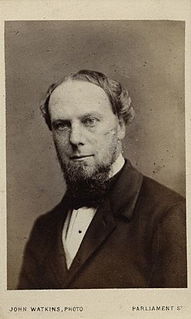
John Wodehouse, 1st Earl of Kimberley,, known as The 3rd Baron Wodehouse from 1846 to 1866, was a British Liberal politician. He held office in every Liberal administration from 1852 to 1895, notably as Secretary of State for the Colonies and as Foreign Secretary.
Sir John Soane was an English architect who specialised in the Neo-Classical style. The son of a bricklayer, he rose to the top of his profession, becoming professor of architecture at the Royal Academy and an official architect to the Office of Works. He received a knighthood in 1831.

Hawkstone Park is a historic landscape park with pleasure grounds and gardens formerly belonging to Hawkstone Hall, near to Market Drayton, in Shropshire, England. It is one mile (1.6 km) east of the A49 road. The park is known for its follies.
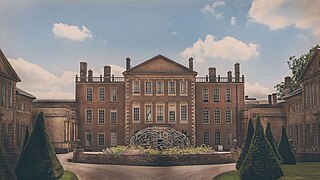
Aynhoe Park, is a Grade I listed 17th-century country house rebuilt after the English Civil War on the southern edge of the stone-built village of Aynho, Northamptonshire, England. It overlooks the Cherwell valley that divides Northamptonshire from Oxfordshire. The house represents four architectural periods: Jacobean, Carolean and both the early 18th and 19th centuries. The house is in private ownership and no longer open to the public but can be hired for some private functions.

Tyringham Hall, (/ˈtiːrɪŋəm/) is a Grade I listed stately home, originally designed by Sir John Soane in 1792. It is located at Tyringham near Newport Pagnell, Milton Keynes.

Burnham Market is an English village and civil parish near the north coast of Norfolk. Burnham Market is one of the Burnhams, a group of adjacent villages. It resulted from the merger of three of the original Burnham villages: Burnham Sutton, Burnham Ulph and Burnham Westgate.

Fawley Court is a country house, with large mixed-use grounds standing on the west bank of the River Thames at Fawley in the English county of Buckinghamshire. Its former deer park extended east into the Henley Park area of Henley-on-Thames, Oxfordshire that abuts it to the south. Following World War II, it was run as Divine Mercy College by the Polish Congregation of Marian Fathers, with its associated library, museum and was one of the cultural centres for the Polish minority in the United Kingdom until its closure and sale in the 2009. It is listed at Grade I for its architecture.
Robert Thornhagh Gurdon, 1st Baron Cranworth, was a British Member of Parliament.
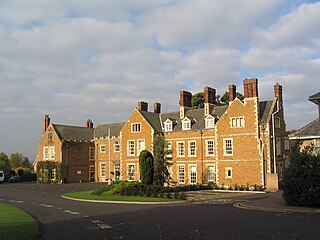
Brooksby Hall is a late–16th-century manor house on 3.2 square kilometres of land between Leicester and Melton Mowbray. Situated 13 kilometres (8.1 mi) northeast of Leicester, the hall and the neighbouring church of St Michael and All Angels are the last remnants of the medieval village of Brooksby, which was founded during the period of the Danelaw in the 9th century AD. In the 15th and 16th centuries Brooksby was depopulated by enclosures carried out by the estate's owners, which turned its cultivated land into sheep pastures in order to profit from a boom in wool.
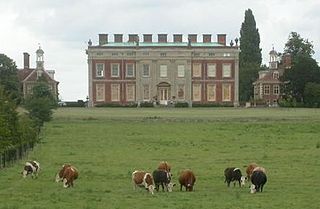
Wotton House, or Wotton, in Wotton Underwood, Buckinghamshire, England, is a stately home built between 1704 and 1714, to a design very similar to that of the contemporary version of Buckingham House. The house is an example of English Baroque and a Grade I listed building.

Walpole Park is a 28 acres (110,000 m2) Grade II municipal park, situated in Ealing. Currently governed by Ealing Council, it was initially the grounds of Pitzhanger Manor, the early 19th-century country home of Sir John Soane. It was acquired by Ealing Council in 1899 and opened to the public for the first time on 1 May 1901. Within its boundaries are additional statutory protected structures: Pitzhanger Manor & Gallery and Lodge. Other attractions featured in its grounds include the late Victorian ornamental Serpentine Lake, bordering the House's rear lawn, and a pond further west with a pair of fountains – both of which attract waterfowl.
John Gurdon was an English politician who sat in the House of Commons variously between 1640 and 1660. He supported the parliamentary cause in the English Civil War.

Brampton Gurdon was an English country gentleman and politician who sat in the House of Commons from 1621 to 1622.
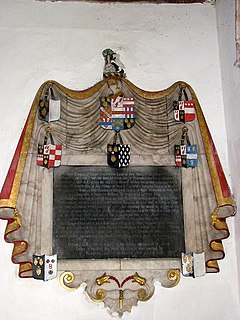
Brampton Gurdon (1606–1669), of Letton in Norfolk, was an English Member of Parliament (MP), lawyer and a colonel of cavalry during the English Civil War.
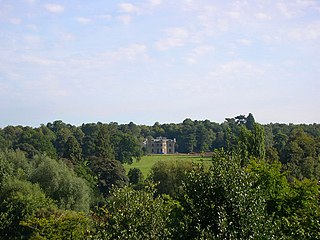
Pell Wall Hall is a neo-classical country house on the outskirts of Market Drayton in Shropshire. Faced in Grinshill sandstone, Pell Wall is the last completed domestic house designed by Sir John Soane and was constructed 1822–1828 for local iron merchant Purney Sillitoe at a total cost of £20,976.

Windlestone Hall is a 19th-century country house situated near Rushyford, County Durham, England. It is a Listed building.
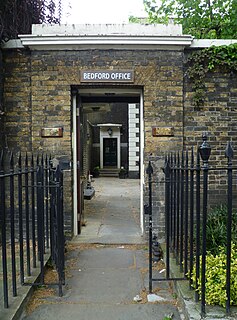
The Bedford Estate is an estate in central London that is owned by the Russell family, which holds the peerage title of Duke of Bedford. The estate was originally based in Covent Garden, then stretched to include Bloomsbury in 1669. The Covent Garden property was sold for £2 million in 1913 by Herbrand Russell, 11th Duke of Bedford, to the MP and land speculator Harry Mallaby-Deeley, who sold his option to the Beecham family for £250,000; the sale was finalised in 1918.

Bentworth Hall is a country house in the parish of Bentworth in Hampshire, England. It is about 1 mile (1.6 km) south of Bentworth village centre and 4 miles (6.4 km) northwest of Alton, the nearest town.

Gordon House is a large 19th-century detached house in Chelsea, London, SW3. The house is sited in two acres of the south west corner of the grounds of the Royal Hospital Chelsea. It was designed by Thomas Leverton for Colonel James Willoughby Gordon. The house became part of the Royal Hospital following Gordon's death in 1851, and has recently been converted into a private residence.

52.945788°N 0.722072°E
| This article about a Norfolk building or structure is a stub. You can help Wikipedia by expanding it. |